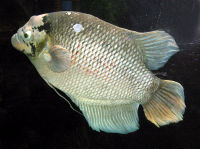Giant Gourami (Osphronemus goramy)
From The Aquarium Wiki
Revision as of 21:27, 23 March 2015 by HalfbeakedGar (talk | contribs)
Giant Gourami
Osphronemus goramy
1325 Litres (350 US G.)
60-70 cm (23.6-27.6")
Freshwater
6.5 - 8.0
20 -30 °C (68-86°F)
20-25 °d
1:1 M:F
12-25 years
Family
Osphronemidae
Contents
Additional names
- Giant Gourami, Common Gourami, True Giant Gourami
Additional scientific names
- Osphronemus gourami, Osphronemus olfax, Osphronemus notatus
Origin
- Asia: probably limited to Sumatra, Borneo, Java, the Malay Peninsula, Thailand and Indochina (Mekong basin).
Sexing
- The dorsal and anal fins of the male are pointed, they are shorter and rounded on females.
Tank compatibility
- A large generally peaceful fish that should be kept in a very large spacious tank with similar sized fish such as Silver Dollars. Smaller fish may be preyed upon.
Diet
- Will accept most foods including pellet and flake, blanched vegetables and live/frozen food such as earthworms, bloodworm, shrimp, and insects.
Feeding regime
- Feed once or twice a day.
Environment Specifics
- This fish is a known "tankbuster" and should not be taken on unless an exceptionally large home can be provided for it. It needs excellent filtration, and hiding places provided with planting and bogwood.
Behaviour
- A generally peaceful large fish.
Identification
- The largest of the Gouramis, the Giant Gourami is oval-shaped and laterally compressed. They have long ventral "feelers". Young fish have a pointed head, while older individuals have a small, blunt head with a pronounced lower jaw, giving them a large "chin". Young fish are reddish brown to dull orange with a number of brown, transverse bands. The fins are orange. As the fish gets older, it becomes less attractive and loses its handsome stripes. Adults have a dark brown back and brown flanks covered with iridescent silver scales. The fins are also brown. Albino and other colour variations are common.
Pictures
External links
- Fishbase (Mirrors:
 )
)



